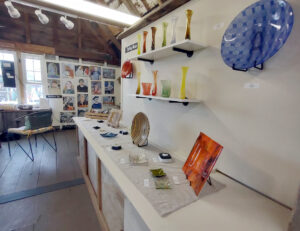
As I told you last week, I’m in Albany wrasslin’ my grandson while my daughter is in hospital. My granddaughter has arrived. She’s in the NICU now, and covered with the usual tubes, wires and tapes. I can’t say who she looks like, but she cries like a baa-lamb and grasps her daddy’s finger. Her mom is being tapered off her hospital drugs, so I think we’ve turned a corner. Thank you all for your kind thoughts and prayers.
Buy a painting to match your sofa
“Art should make you think and feel. It doesn’t have to match your couch,” has been a catchphrase for as long as I can remember. But why shouldn’t art match your furnishings? You probably chose them because you liked them, and you’re likely to like a painting that coordinates with them for the same reason.

That doesn’t mean a painting should literally match your couch, but it’s okay if they share touchpoints. Still, I’ve noticed that even the most talented designers among my collectors buy art based on how it resonates with them, rather than what it matches. Dare to be inventive; traditional painting can match contemporary spaces and vice-versa.
The famed collector Dr. Albert Barnes believed grouping paintings in terms of light, space, color and line could create a whole that was greater than the sum of its parts. (This is why the Barnes Foundation‘s indenture of trust stipulated that the paintings in the collection be kept “in exactly the places they are,” leading to years of legal wrangling.) Some paintings just look better with others, and the only way to know is to pair them and see what happens.
Buy a painting because you love it, but when you go to hang it, consider:
Color: I once had a room with a red ceiling. It cast such a warm reflection on the room that cool colors were washed out. It made more sense to hang landscapes in another room.
Size: It would be absurd to place a 6”x8” painting in solitary splendor on a 12’ wall, and an oversized painting can dwarf a small living space. A good rule of thumb is that a painting should take up 60-75% of the allotted space, such as above your couch or bed. However, there are times when breaking that rule can work spectacularly.
Purpose: I’ve learned from personal experience that a nude in the dining room might embarrass your family. “Could we please take it down for Thanksgiving?” one of my kids asked.
Scale: While there’s some truth to the adage that a painting should read as well at 30 feet as 3 feet, there are some works (like etchings or botanical prints) for which that makes no sense. They need to be hung where they can be appreciated up close, like in an office or, yes, a powder room.
Mood: I have a vibrant multimedia piece by Barbra Whitten that’s destined to my kitchen. It’s based on a layered salad and will sing in that light, airy space. It joins a nocturne by Chrissy Pahucki of her daughter making s’mores over a fire. My living spaces have high-chroma paintings by Chrissy Nickerson, Poppy Balser, Tom Conner, Bruce McMillan and Bruce Bundock, among others. The only paintings in my bedroom are of family members.
Of course, I’m constantly shuffling paintings as I acquire new art. I have another Tom Conner and a watercolor by Barbara Tapp that need homes. I don’t consciously choose paintings that meet the purpose of the room, but it seems to end up that way.
Frames: I don’t think there’s a specific frame that matches a particular painting style; it’s more about aligning with your room’s design. If you love the painting but hate the frame, ask the artist for the price unframed. He or she will almost always accommodate that.
Don’t forget, there’s $100 off any painting on my website, from now until the end of the year. Just use the code XMAS100.
Reserve your spot now for a workshop in 2025:
- Advanced Plein Air Painting, Rockport, ME, July 7-11, 2025.
- Sea and Sky at Acadia National Park, August 3-8, 2025.
- Find Your Authentic Voice in Plein Air, Berkshires, MA, August 11-15, 2025.
- Immersive In-Person Fall Workshop, Rockport, ME, October 6-10, 2025.













